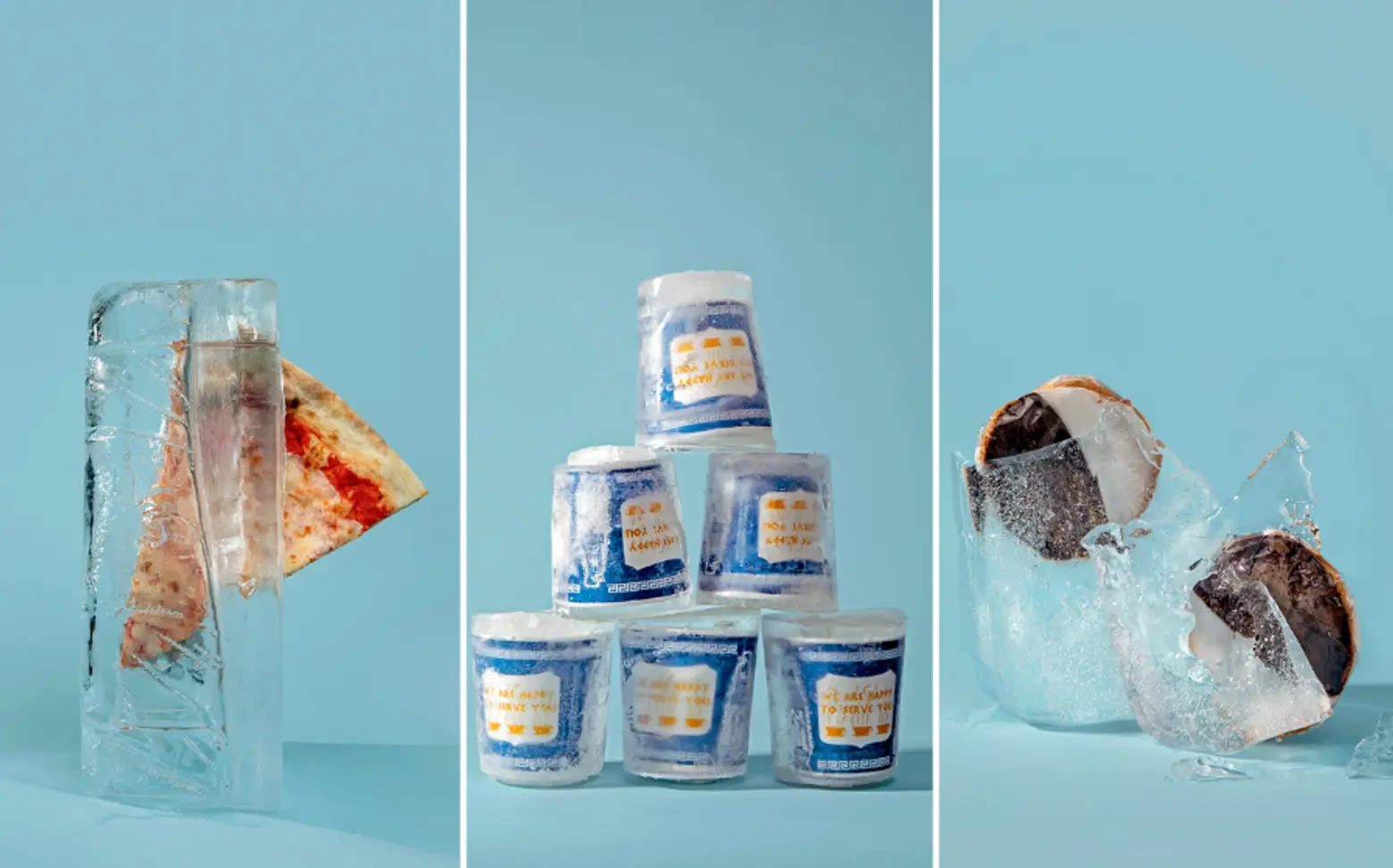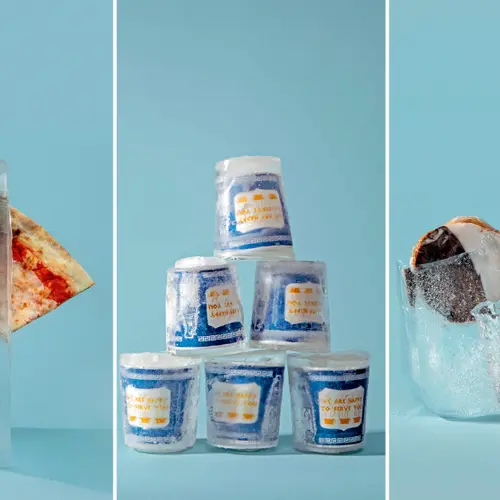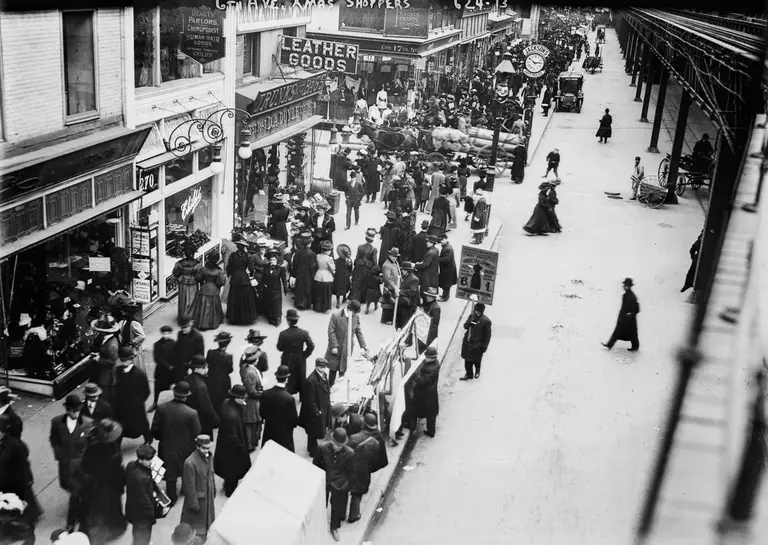The Urban Lens: ‘Manhattan Meltdown’ photo series aims to preserve and celebrate food of NYC

6sqft’s series The Urban Lens invites photographers to share work exploring a theme or a place within New York City. In this installment, Aaron Bernstein shares his “Manhattan Meltdown” photo series of famous NYC foods, frozen. Are you a photographer who’d like to see your work featured on The Urban Lens? Get in touch with us at [email protected].
Photographer Aaron Bernstein was overwhelmed when he first moved to New York City for his career in fashion. One way to adjust to his new home was through different food experiences. “Food was this daily thing that I could measure small successes with,” Aaron told us. “If I was able to cook for myself or buy myself a meal, I saw it as a tiny victory.” And now as an Adobe Creative Resident, Aaron is exploring the intersection of food and art through the “digital guise” of “Hungry Boy,” an online platform that shows off his colorful, food-centric photos.
Aaron recently shared with 6sqft his “Manhattan Meltdown” series, which features beloved food seen as synonymous with the city’s culture– from Anthora coffee cups to black and white cookies from William Greenberg Desserts, all encased in ice. While the photos are fun and playful, they also represent a bigger truth about the disappearance of beloved Manhattan mom-and-pop shops due to skyrocketing rents and the growing popularity of big businesses. Ahead, get a taste of Aaron’s work and hear what the photographer has planned next.

Coffee (various): This infamous design known as Anthora was introduced in 1963 to appeal to the city’s many Greek-owned coffee shops. Clearly, this worked—these cups quickly became a symbol of daily life, and could be found everywhere from street vendors to corner delis. With coffee culture today favoring more upscale, boutique shops, these cups are harder to come by. In 2006, the design was discontinued. The Solo Cup Company acquired the trademark and brought them back into circulation in 2015.
You have a fashion background. What made you transition into photography?
I’ve always had an interest in photography from an early age. I found fashion an exciting world to explore behind the lens, and it married my interests in being able to create and capture a specific aesthetic and invent my own little worlds. I have only been involved in the fashion world from a photography point of view–be it assisting on sets, working in production, creating original content for social outlets, shooting editorial commissions, or freelancing as a photographer with miscellaneous brands.

Pizza (Patsy’s Pizzeria): Pizza trends may come and go, but the traditional New York thin crust style remains king when it comes to one of the most lauded foods in town. Patsy’s Pizzeria in East Harlem has been serving up their infamous pies since 1933, where they even consider themselves the inventors of this style. Patsy’s is an indisputable food landmark that is still running strong today.
Why did you decide to use your Adobe Creative Residency to explore food?
After moving to New York City to continue a career in fashion, I was extremely overwhelmed. Food was this daily thing that I could measure smaller successes with: if I was able to cook for myself or buy myself a meal, I saw it as a tiny victory. I began to explore the city by way of food. Growing up in a family that loves to cook, I’ve always had an appreciation for food.
Over time I began to implement it into my personal photography work, and eventually decided I wanted to make more of an effort to incorporate into my professional career. I’m really interested in translating the ideas of style that initially drew me to fashion to the food world, so the Adobe Creative Residency seemed like the perfect first step to really be able to fully begin the exploration.

Soft Pretzels (street vendors): Either too hard, too chewy, too bland, or too salty, the unspoken secret of this street food is that, culinarily, it isn’t actually all that great. However, the cheap prices (especially compared to other city snacks) and availability on almost any corner—touristy or not—has made soft pretzels into a New York City classic that has managed to stay relatively unchanged for almost two centuries.
Tell us a bit more about “Hungry Boy.”
“Hungry Boy” is a digital hub that I launched as a part of my residency to explore the intersection between food, art, and style through photography-based projects. Over the past ten months, it has morphed into various photography and stop-motion animation projects, as well as a space to reflect on my own journey with food through personal essays.
As a part of the residency, I’ve also launched “All On The Table,” a podcast that brings New York City-based creatives over shared meals to discuss navigating their own experiences with the city, food, and their careers. After the residency wraps up in May, I plan to continue “Hungry Boy” as a natural extension of my professional career, working with like-minded clients and brands that are interested in using food as a navigational tool to reflect facets of contemporary culture.

Black & White Cookies (William Greenberg Desserts): The history of the black & white cookie can be traced back to the recently shut down Glaser’s Bake Shop in Yorkville, which opened its doors in 1902. With a cake base covered in half vanilla and half chocolate icing, these decadent cookies can now be found all over New York City, in both old and new places alike. William Greenberg Desserts on 82nd and Madison is perhaps the most well known for this treat. They have been supplying the city with a variety of kosher baked goods since the 1940s.
How have you seen the food scene change in recent years?
This push for the convenience factor has been really apparent to me, especially in New York. There are a lot of quick-serve, made to order spots that have seeped over from being just quick lunch places to viable options for any meal of the day. These places are rapidly expanding, and somewhere like New York seem to be embracing this shift. This was part of my inspiration for the “Manhattan Meltdown” project–as commercial rents dramatically increase overnight, the only places that can afford to take over such property are mainly these big businesses. Massive food halls are being favored to smaller, start-up restaurants.
On the flip side, I’ve also noticed an increase in people hosting their own dinner parties, supper clubs, and food experiences. Perhaps this is in reaction to all of the big business taking over. It’s kind of polarizing to me to have these two options so prevalent right now: one one hand buying into the no-frills on-the-go spots in the chaos of the city, and on the other having an intensely personalized experience over home-cooked meals in an intimate setting.

Dim Sum (Nom Wah Tea Parlor): While some might argue that the most authentic dim sum can be found over in Flushing, the diverse offerings that Manhattan’s own Chinatown brings to the table is impressive nonetheless. What is traditionally served as a brunch food has become in demand at all hours of the day. Though rapidly expanding, the history of Nom Wah Tea Parlor cannot be denied. Open for nearly a century, it has withstood the test of time on the curve of Doyers St., surviving as one of the most notable restaurants on one of the most history-laden streets of Manhattan.
Are there any restaurants that you especially miss?
When I first moved to New York, I lived in Chinatown. Before it closed, Prosperity Dumpling was my savior. It was so cheap and really good! That is, of course, until they were shut down for health reasons…

Egg Cream (Eisenberg’s): While the details of its origin story are heavily debated, egg creams were born in New York City in the late nineteenth century, quickly becoming a staple drink in soda shops thereafter. Funnily enough, egg creams don’t contain actual egg or cream in them. They are composed of chocolate syrup, seltzer, and milk. Today, you can find this classic at places like Eisenberg’s Sandwich Shop, a neighborhood favorite since 1929 known for this drink (and many other deli standards) on 22nd and 5th.
What would you say is your most favorite NYC food?
I’m not sure it counts as an NYC specific food, but I really love ice cream and have a lot of respect for all of the local spots that do it justice. I’ve spent a lot of time sampling as many places as I can. A personal favorite is Ample Hills. When I was living in Chinatown I would often supplement a proper meal with Chinatown Ice Cream Factory.

Hot Dogs (Papaya King): There’s nothing more New York than washing down a salty hot dog with a fresh tropical fruit juice, all thanks to Papaya King in the Upper East Side. Initially just a juice stand, Papaya King added hot dogs to its menu in the 1930s to better cater to the German and Polish residents of the neighborhood. Today, a considerable amount of hot dog and fruit juice spots can be found all around Manhattan, but Papaya King still stands strong as the proud original on the corner of 86th & Lexington.
What else are you working on?
Right now I’m heading into production on Season 2 of “All On The Table” which will bring food-based creatives together to discuss their use of technology in their craft. I’m also working on the next steps of an ongoing collaboration I have with a fellow creative resident Isabel Lea called “Feast Your Eyes” that explores food and language through various photo and design-based projects.
Captions writen By Aaron Bernstein; all photos © Aaron Bernstein








































